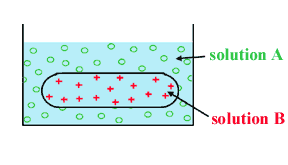
Solutions A and B are isosmotic
The solute particles + and
o are non-penetrating.
Will the dialysis bag change shape or not?
1- Identify all the different type of solute particles
in all the compartments of the system.
The solute particles in solution A are o.
The solute particles in solution B are +.
2- Figure out what each type of solute particles "want to do".
The o want to move along
their gradient of potential energy
(in this case along their gradient of concentration).
They want to move in the dialysis bag (into the solution B).
Can they do it? NO -
They are non-penetrating and this means they
cannot cross the membrane of the dialysis bag.
The + also want to move along
their gradient of potential energy
(in this case along their gradient of concentration).
They want to move out of the dialysis bag and into the surrounding solution (A).
Can they do it? NO -
They are non-penetrating and this means they
cannot cross the membrane of the dialysis bag.
Both o and + will stay where they are.
3- Make them do it.
NO WAY!
4- After they have "done it" figure out the
overall concentration of all the solute particles (or osmolarity) in each compartments
The two solutions were isosmotic to start with.
This means that they have the same concentration of
solute particles. As no solute can cross
the dialysis membrane, the two solutions will stay isosmotic.
5- predict the movement of water
The potential energy for water is the same in the two solutions
because their concentration of solute particles is the same.
This means there
is no net movement of water from one compartment to another.
6- figure out how the shape of
the dialysis bag will be affected.
The shape of the dialysis bag will not be affected ---> The solution A is isotonic.

